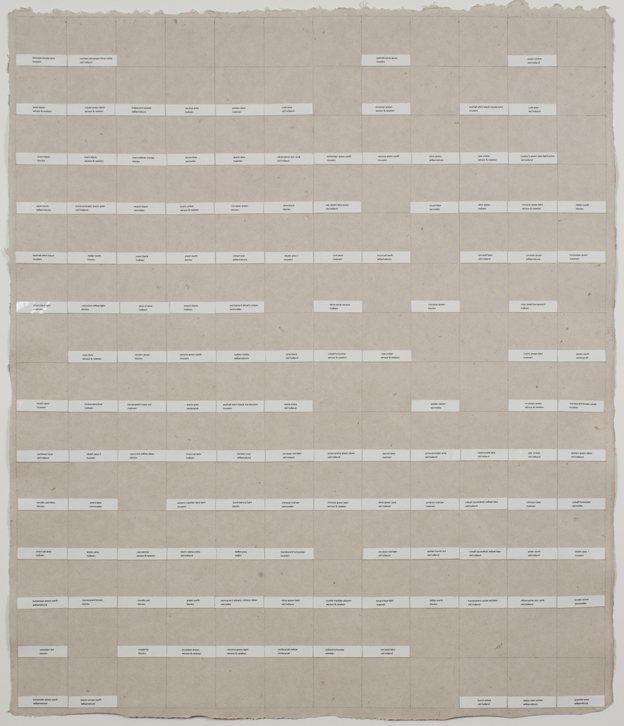
For the viewer familiar with Nancy Haynes’s immersive, introspective paintings, it may be a surprise to encounter work by the artist completely devoid of color. However, closer engagement with memory drawing (John Cage + Merce Cunningham) from 2010 reveals that color is present despite its material absence. Like the majority of her work, Haynes’s recent “memory drawings” operate on the paradox of representing presence through absence. Her longstanding interests in conceptual art and Buddhist philosophy are major sources of her exploration of this paradox. While Haynes has always considered herself a conceptual artist, her recent “autobiographical color charts” are more insistent on this fact, functioning as works that describe (her language suggests a textual analogy) their own nature. In speaking of her work in general, Haynes also refers to a process of “reading” her art.1
Memory drawing (John Cage and Merce Cunningham) is part of a drawing series that forms a counterpart to Haynes’s autobiographical color chart paintings. The autobiographical paintings and drawings appear to engage with two major formal preoccupations of the twentieth century: the grid and the monochrome. Yet to read Haynes’s color charts exclusively in terms of their relationship to art history overlooks their more private “sentimental” meaning. Haynes refers to this recent body of work as “sentimental conceptual art”: conceptual statements that are simultaneously poignant reflections of her own work. According to Haynes, the autobiographical color charts are deeply personal; the colors and paints trigger memories specific to her own use of them. The “memory drawings” transcend the intimate and the personal, however, by forcing each viewer to reconstruct the colors in his or her mind. Thus, the “memory drawings” are poetic reflections of both Haynes’s private experience as an artist, and of the process of making and beholding art.
Haynes began to create the “memory drawings” several years ago in Colorado, where the climate prevented her from working in oil paint. She turned to text as a mnemonic stand-in for the colors that filled her paintings, incorporating small printed labels bearing the names of paints and their manufacturers. The drawings also differ from their painted counterparts in that they pay homage to specific artists who have inspired Haynes. She is particularly attracted to the spirit of artistic experimentation that she feels characterizes the 1960s, and the majority of her touchstones are well-known artists such as John Cage, Merce Cunningham, and Agnes Martin—to whom she dedicates another memory drawing. Haynes also devotes a drawing to Marcel Duchamp and chess.
In addition to the artists to whom Haynes pays tribute in her drawings, another work that influenced Haynes’s conception of the autobiographical color charts is Jasper Johns’s Wilderness I (1963-70). Part graphic and part sculpture—it includes various objects such as a ruler, a resin hand, and a paintbrush—Johns’s drawing also alludes to the process of making art and the play between color and text. The words RED, YELLOW, and BLUE, stenciled in gray wash, create tension between the appearance of the words and their signification.2 Like the expressions of gratitude she extends to influential artists in her drawings, Haynes conveys a similar sentiment in discussing Johns’s drawing, referring to it as a “generous and modest, yet monumental statement about making art.”3
In speaking of her autobiographical color charts, Haynes invites another textual analogy, likening these works to the “table of contents” of her life. By sharing her table of contents with others, Haynes builds upon the generosity of her artistic forebears, offering her own thoughtful meditation on the joys of viewing—or “reading”—art.
1. Nancy Haynes, in discussion with the author, 29 June 2011.
2. Pamela Lee, “Jasper Johns: Wilderness I (1963-70)” originally printed in Drawing is another kind of language: Recent American Drawings from a New York Private Collection, Pamela M. Lee and Christine Mehring (Cambridge, MA: Harvard University Art Museums, 1997), accessible at http://www.aboutdrawing.org/essay/view/53.
3. Nancy Haynes, in discussion with the author, 29 June 2011.
Nancy Haynes Biography
Elizabeth Donato Biography